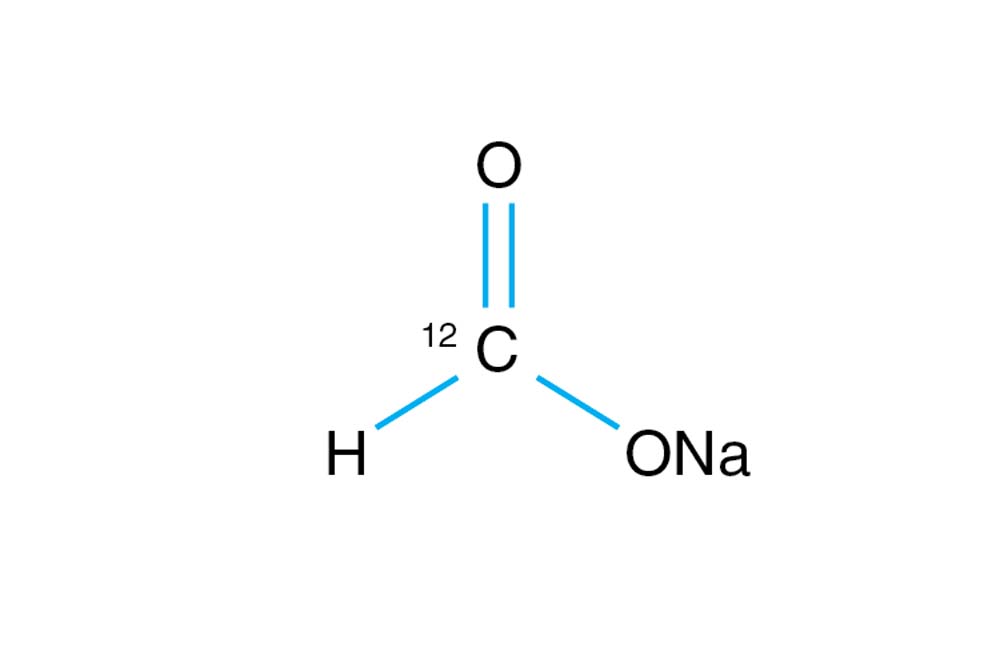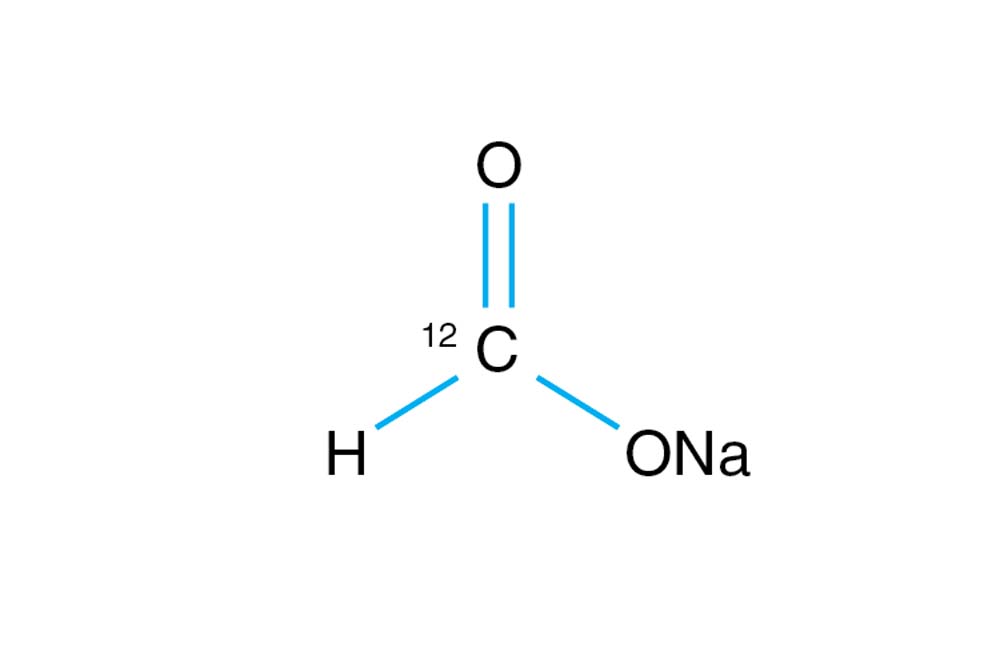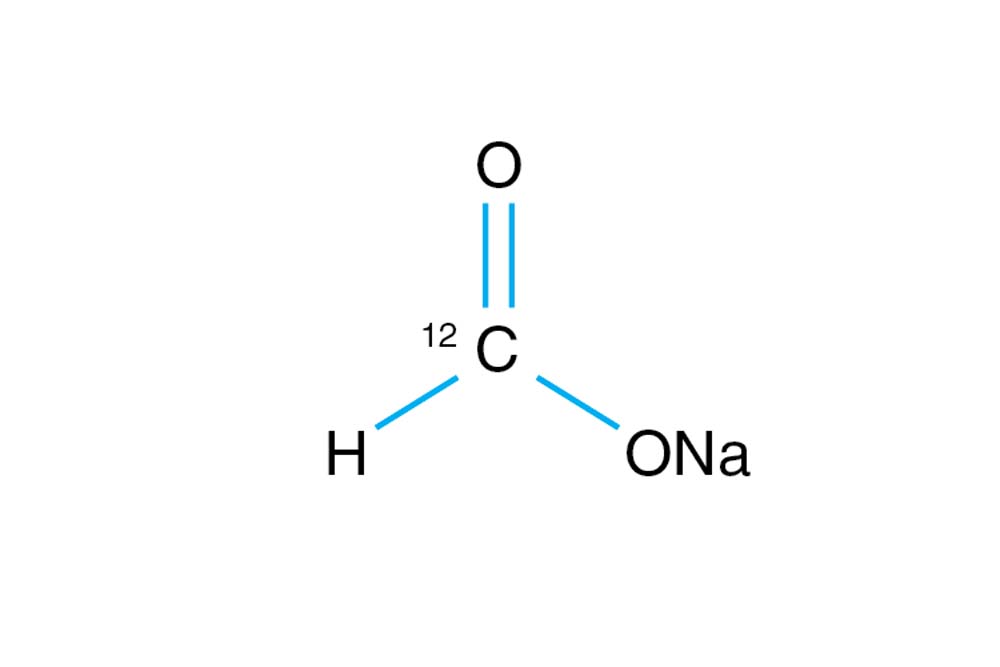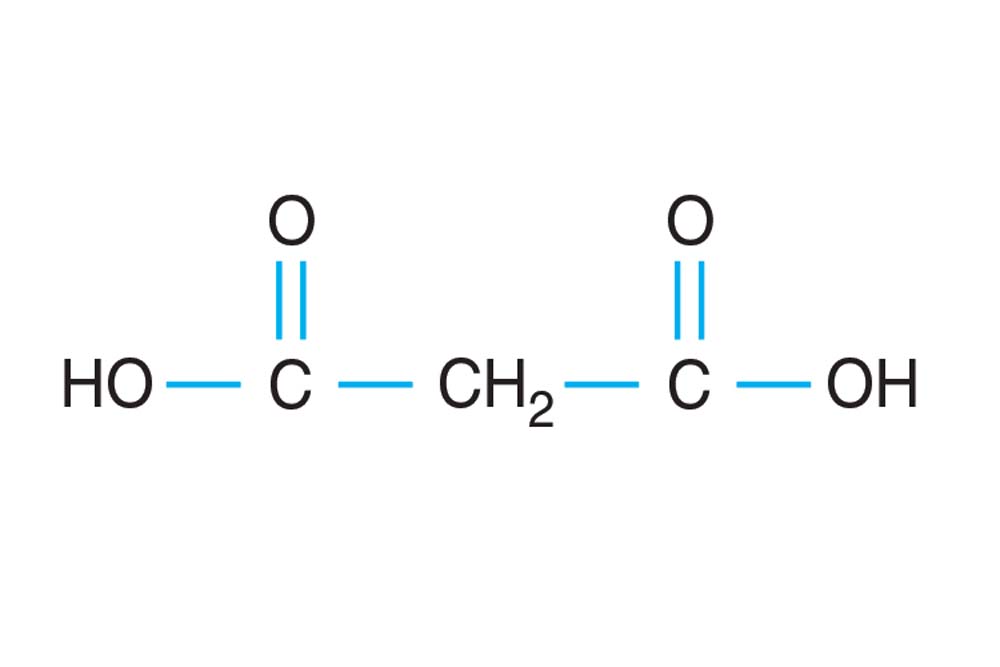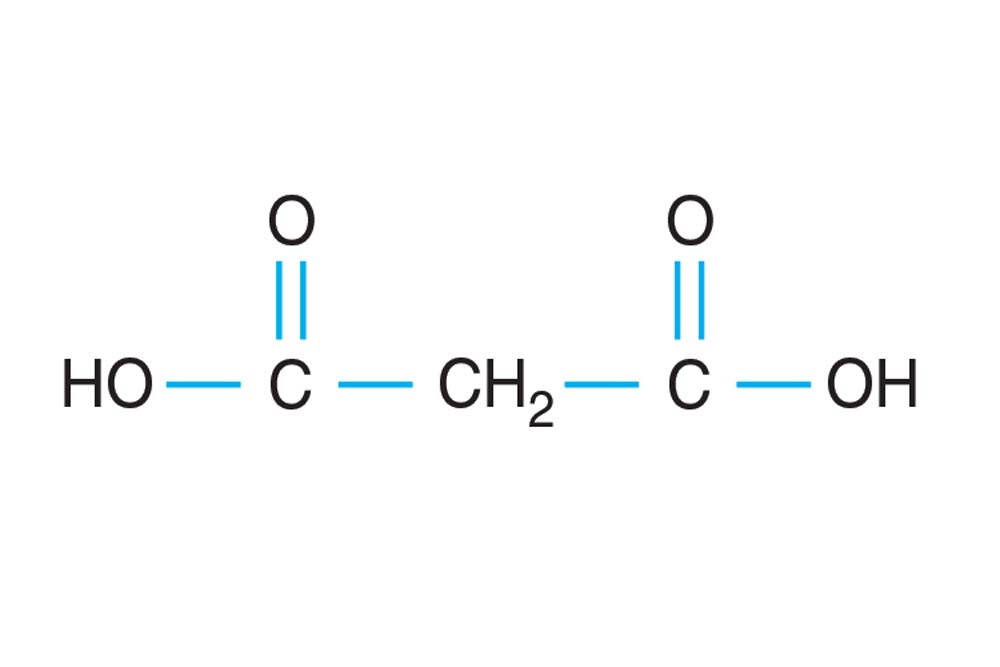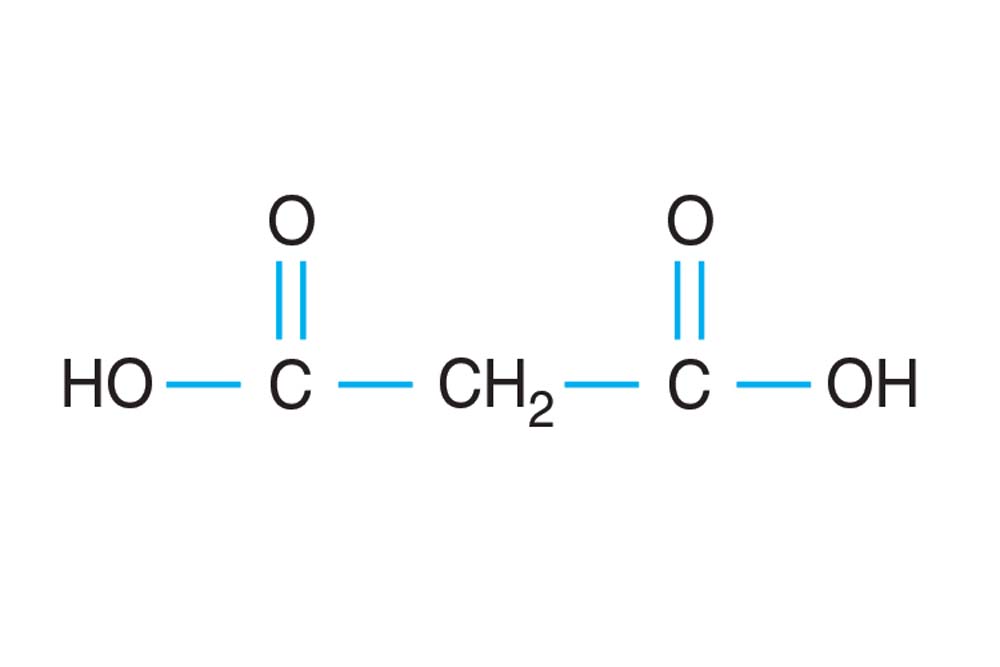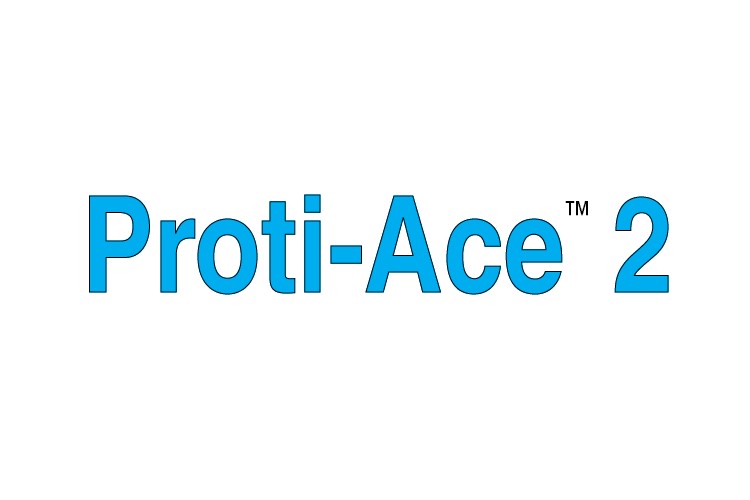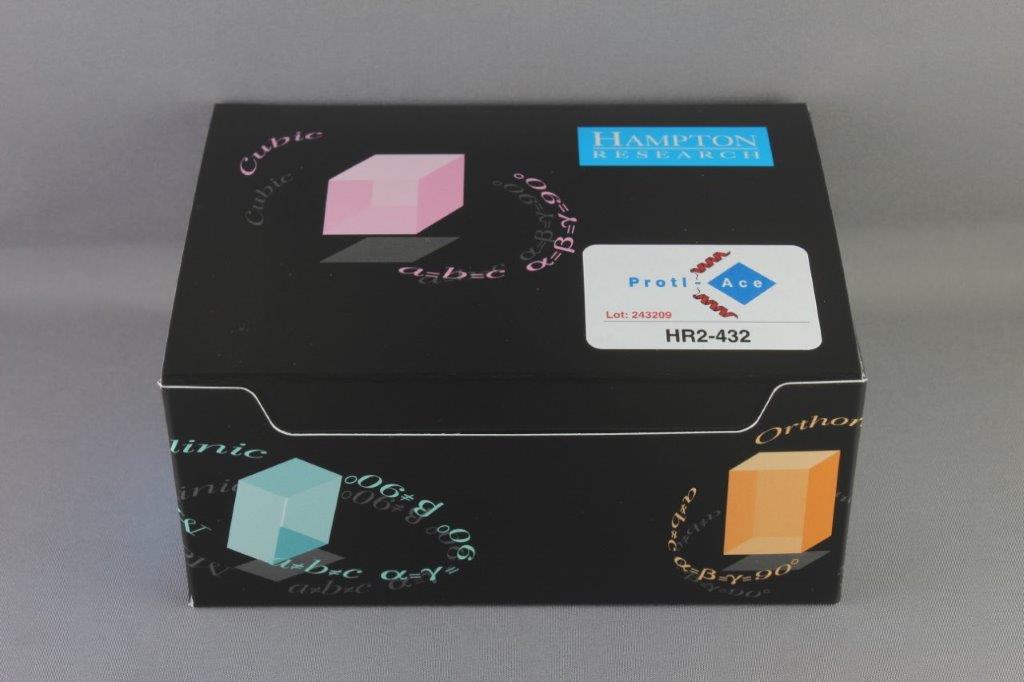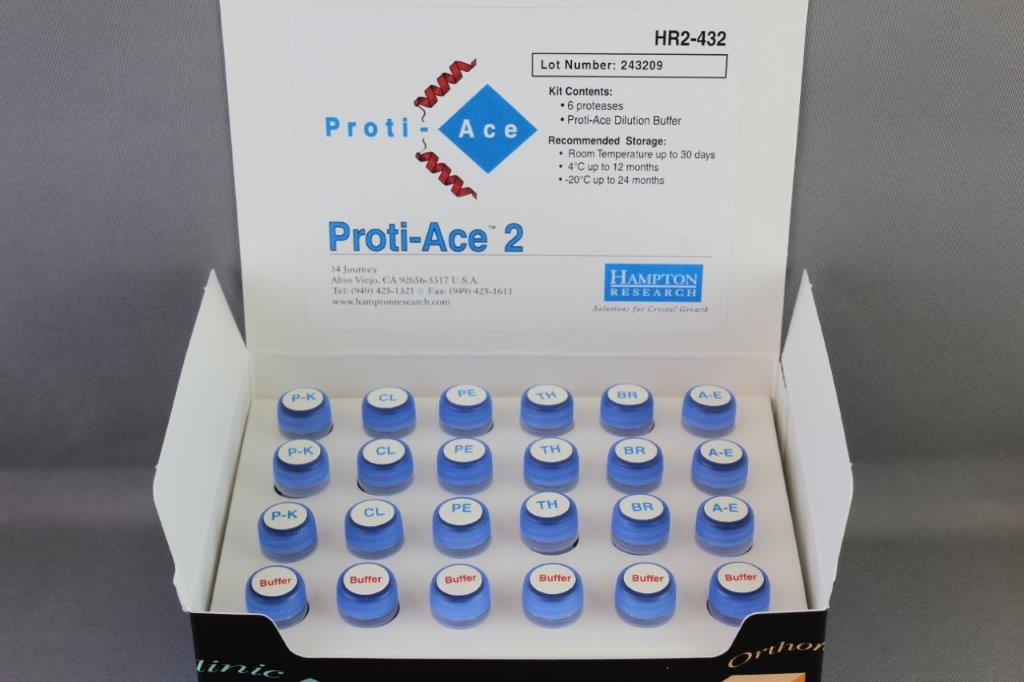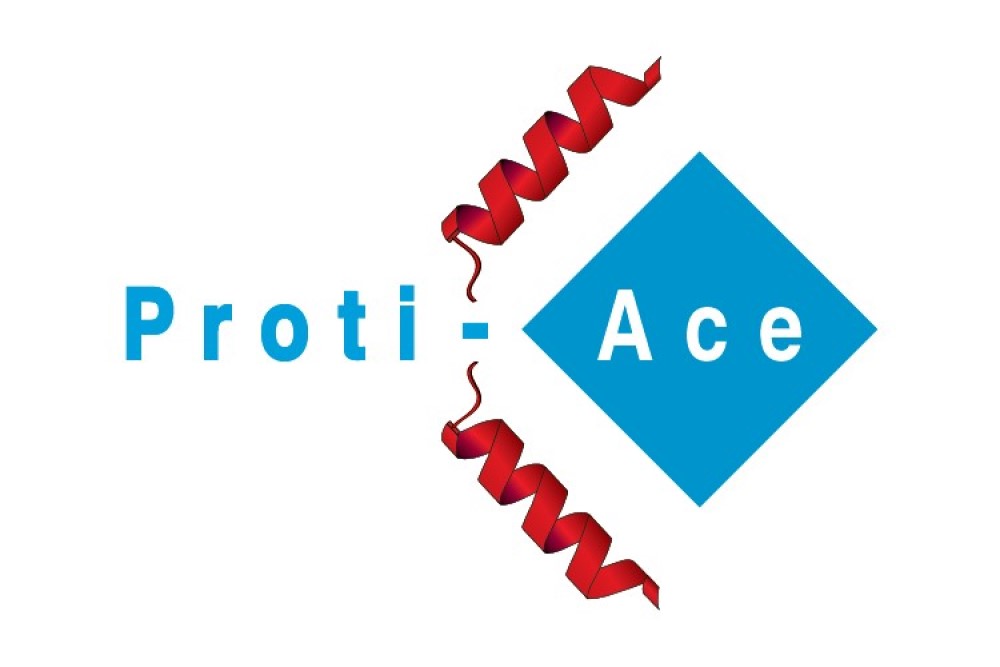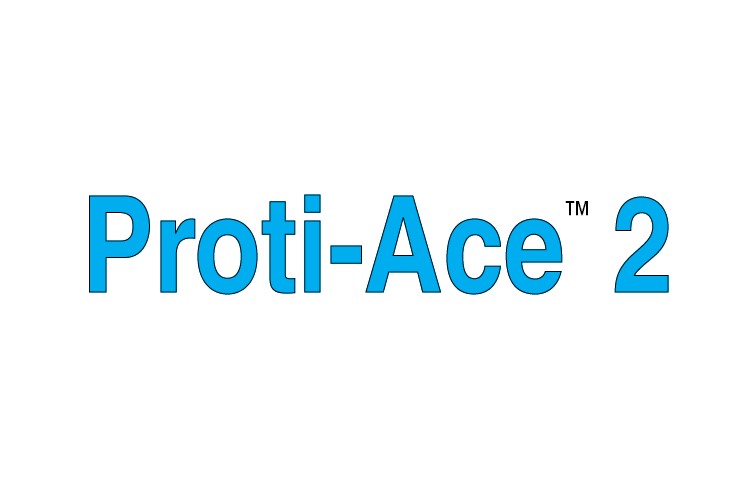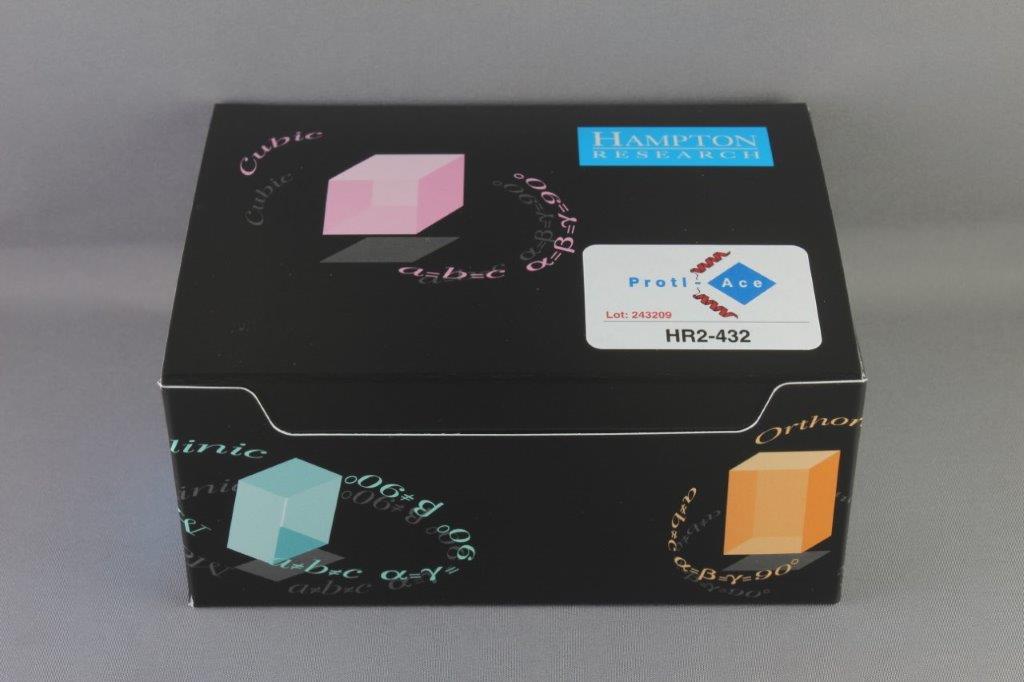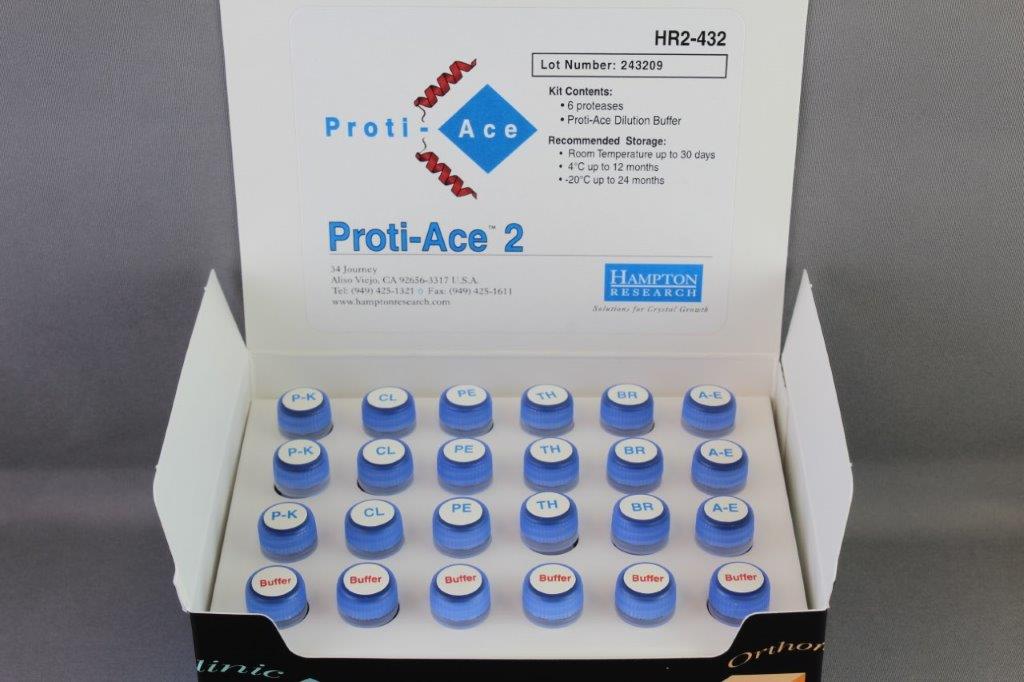lumiprobe荧光染料官网代理商 水溶性荧光染料代理商 脂溶性荧光染料代理商
- Products
- Reactive dyes
- Dye azides
- FAM azide, 6-isomer
FAM azide, 6-isomer
| Cat. # | Quantity | Price | Lead time | Buy this product | ||||||||
|---|---|---|---|---|---|---|---|---|---|---|---|---|
| 15130 | 100 uL, 10 mM/DMSO | 80.00$
|
||||||||||
| 35130 | 500 uL, 10 mM/DMSO | 100.00$
|
||||||||||
| 45130 | 1 mL, 10 mM/DMSO | 150.00$
|
||||||||||
| A5130 | 1 mg | 80.00$
|
||||||||||
| B5130 | 5 mg | 100.00$
|
||||||||||
| C5130 | 10 mg | 150.00$
|
||||||||||
| D5130 | 25 mg | 295.00$
|
||||||||||
| E5130 | 50 mg | 450.00$
|
||||||||||
| F5130 | 100 mg | 780.00$
|
||||||||||
FAM (fluorescein) azide. solid and 10 mM solution in DMSO, labeling reagent for Click chemistry.
Pure 6-isomer.
Can replace DyLight 488.
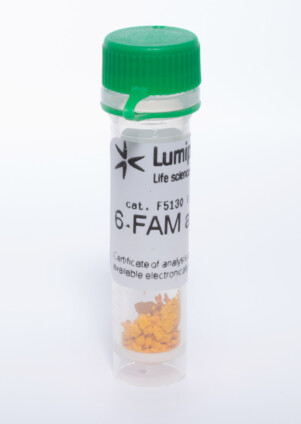
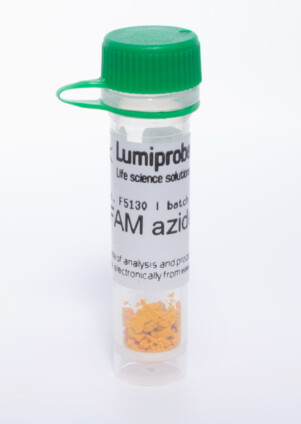
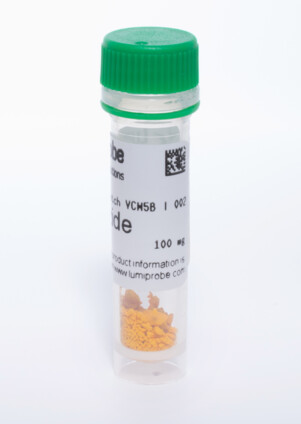
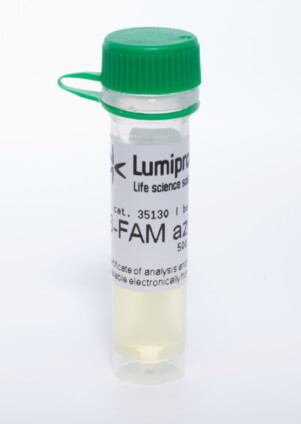
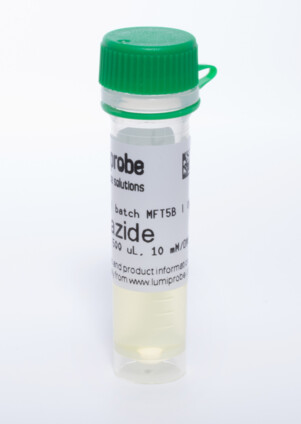
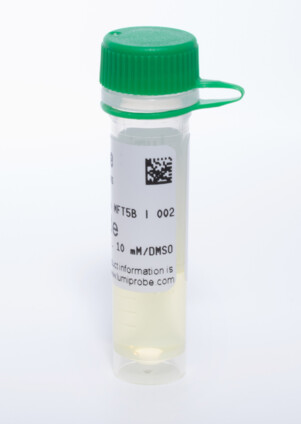
Download in
ChemDraw format
Recommended protocol
Customers also purchased with this product
Amino-11-dUTP
Amino-11-dUTP is a triphosphate for the modification of DNA.
truChIP组织染色质剪切试剂盒 truChIP Chromatin Shearing Tissue Kit
truChIP组织染色质剪切试剂盒
truChIP Chromatin Shearing Tissue Kit
truChIP组织染色质剪切试剂盒(带甲醛进口会收危险品费,建议选择520238无甲醛版本),样本量:20-120mg,0.13-1ml; 基于自动聚焦声波(AFA)技术,等温和可控的剪切克服了传统超声波和酶切方法在染色质剪切时对抗原表位的破坏、操作过程难以优化、无法保证结果的重复性等问题。针对细胞或组织的Covaris truChIP®染色质剪切试剂盒,提供完整可优化的通用protocol,可应用于所有ChIP实验中。 特点: 1.易优化并通用的protocol:Covaris全套解决方案将摸索时间缩短至1-2周; 2.高重复性:AFA精确控制,系统稳定,完成条件摸索后即可稳定的得到好的结果; 3.良好的温控:AFA等温处理,保护蛋白抗原表位,提高免疫沉淀和DNA的回收率; 4.超低起始量:FFPE样本、稀少珍贵的细胞组织做ChIP也可保障简便高效、高得率; 5.剪切金标准:Covaris片段化重复性、剪切无偏好、片段长度分布均为测序业内金标准; 6.可选SDS或非离子剪切缓冲液,SDS用量仅为常规方法1/10,减少SDS对IP过程中抗体的影响,无需进行样品稀释直接用于下游IP,提高IP效率。
| 货号 | 产品名称 | 品牌 | 购买 |
|---|
| 货号 | 名称 | 单位 | 购买 |
|---|---|---|---|
| 520237 | truChIP组织染色质剪切试剂盒 | 1 kit | 咨询客服 |
SacI(即将停产)–NEB酶试剂
SacI(即将停产) 收藏














Download:
识别位点
- isoschizomers |
- compatible ends |
- single letter code
停产通知
此产品即将停产,库存售完即止,替代产品为高保真(HF)版本 SacI-HF(R3156)
在不同反应缓冲液的活性
NEBuffer 1.1: 100%
NEBuffer 2.1: 50%
NEBuffer 3.1: 10%
CutSmart Buffer: 100%
特性
重组酶、省时酶。
反应条件
NEBuffer 1.1,37℃。
热失活:65℃ 20 分钟。
浓度
20,000 和 100,000 units/ml。
甲基化敏感性
对 dam、dcm 和哺乳动物 CpG 甲基化均不敏感。
注意事项
当盐浓度高于 10 mM 时,Sacl 的活性被抑制。小量制备 DNA 中残留的盐会阻碍 Sacl 的酶切作用。用70% 乙醇漂洗或透析可以除去盐分。
Sodium formate蛋白结晶试剂盒Hampton Research
Hampton Research蛋白结晶试剂盒






Products > Optimize Reagents > Optimize – Salts > Sodium formate
Sodium formate
Applications
- Crystallization grade Sodium formate for formulating screens or for optimization
Features
- Sterile filtered solution
- Formulated in Type 1+ ultrapure water: 18.2 megaohm-cm resistivity at 25°C, < 5 ppb Total Organic Carbon, bacteria free (<1 Bacteria (CFU/ml)), pyrogen free (<0.03 Endotoxin (EU/ml)), RNase-free (< 0.01 ng/mL) and DNase-free (< 4 pg/µL)
Description
Sodium formate
Synonyms: Formic acid sodium salt
CHNaO2
HCOONa
Mr 68.01
CAS [141-53-7]
EC Number 205-488-0
Beilstein Registry Number 3595134
Merck 14,8621
RTECS LR0350000
MDL Number MFCD00013101
PubChem Substance ID 24886222
Purity ≥ 99.0%
HR2-547 pH Range: 8.2 – 9.5 at 25°C
HR2-547 Measured Conductivity Range: 107.5 – 121.7 mS/cm at 25°C
HR2-547 Measured Refractive Index Range: 1.38014 – 1.38055 at 20°C
HR2-765 is titrated to pH 7.0 using HCl
HR2-765 Measured Conductivity Range: 121.8 – 137.3 mS/cm at 25°C
HR2-765 Measured Refractive Index Range: 1.36867 – 1.36929 at 20°C
Total Impurities: Insoluble matter, passes filter test
Al ≤0.0005%
As ≤0.00001%
Ba ≤0.0005%
Bi ≤0.0005%
Ca ≤0.001%
Cd ≤0.0005%
Cl ≤0.005%
Co ≤0.0005%
Cr ≤0.0005%
Cu ≤0.0005%
Fe ≤0.0005%
K ≤0.01%
Li ≤0.0005%
Mg ≤0.0005%
Mn ≤0.0005%
Mo ≤0.0005%
Ni ≤0.0005%
Pb ≤0.0005%
SO4 ≤0.005%
Sr ≤0.0005%
Zn ≤0.0005%
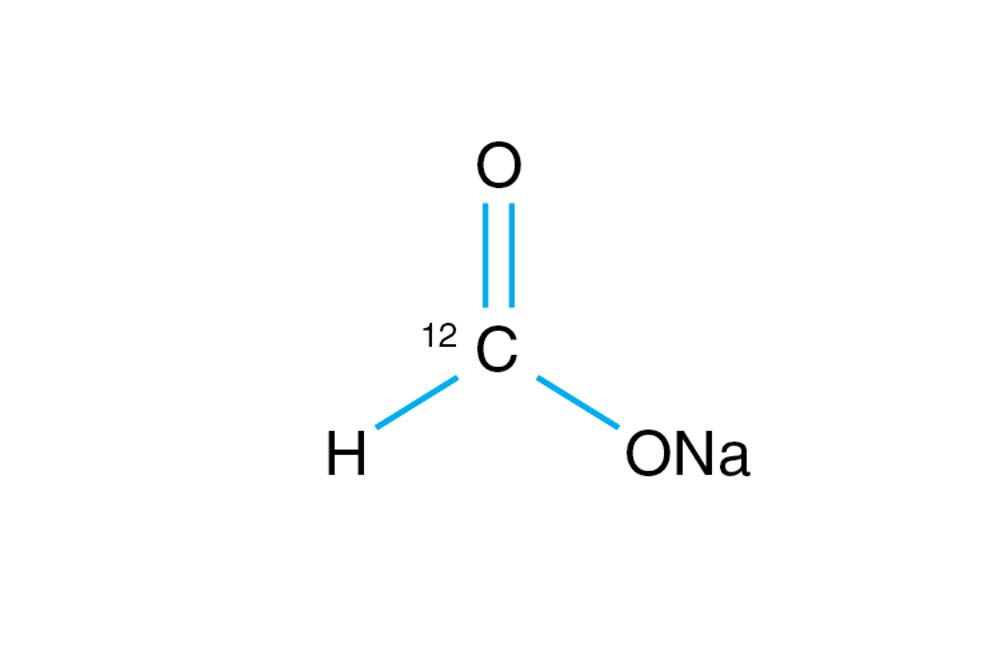
Click to Zoom In
CAT NO
HR2-547
NAME
7.0 M Sodium formate
DESCRIPTION
200 mL
PRICE
$85.00
cart quote
CAT NO
HR2-765
NAME
5.0 M Sodium formate pH 7.0
DESCRIPTION
200 mL
PRICE
$86.00
cart quote
Support Material(s)
 HR2-547 Sodium formate 7.0 M solution SDS
HR2-547 Sodium formate 7.0 M solution SDS HR2-765 Sodium formate pH 7.0 5.0 M solution SDS
HR2-765 Sodium formate pH 7.0 5.0 M solution SDS Certificate Of Analysis
References
1. Crystal structure of the cytoplasmic domain of the chloride channel CIC-0. Sebastian Meyer and Raimund Dutzler. Structure 14, 299-307, February 2006.


Hampton Research, first in crystallization since 1991, developing and delivering crystallization and optimization screens, reagents, plates, and other tools for the crystallization of biological macromolecules, including proteins (antibody), peptides (insulin), and nucleic acids (DNA).
- Products
- Gallery
- My Account
|
|
|
- Contact Us
- Quick Order
- Support
|
- Privacy Policy
- Terms and Conditions
|
- Products
- Gallery
- My Account
- Support
- Contact Us
- Quick Order
- Privacy Policy
- Terms and Conditions
|
|
|
|
|
|
|
© 2021 HAMPTON RESEARCH CORP.
| Website by Skyhound Internet
SUS blade w Cutting Mat 702-001AB 品牌:FUJIFILM Wako
SUS blade w Cutting Mat 702-001AB
|
品牌:FUJIFILM Wako
CAS No.: 储存条件:室温 纯度:– |
| 产品编号
(生产商编号) |
等级 | 规格 | 运输包装 | 零售价(RMB) | 库存情况 | 参考值 |
|
296-39351 |
– | 1pcs | – | 咨询 | – | – |
* 干冰运输、大包装及大批量的产品需酌情添加运输费用
* 零售价、促销产品折扣、运输费用、库存情况、产品及包装规格可能因各种原因有所变动,恕不另行通知,确切详情请联系上海金畔生物科技有限公司。
Fibrillarin (C13C3) 兔单克隆抗体 (Alexa Fluor® 647 偶联) Fibrillarin (C13C3) Rabbit mAb (Alexa Fluor® 647 Conjugate)
Fibrillarin (C13C3) 兔单克隆抗体 (Alexa Fluor® 647 偶联)
Fibrillarin (C13C3) Rabbit mAb (Alexa Fluor® 647 Conjugate)
Fibrillarin (C13C3) Rabbit mAb (Alexa Fluor® 647 Conjugate) detects endogenous levels of total fibrillarin protein.This Cell Signaling Technology antibody is conjugated to Alexa Fluor® 647 fluorescent dye and tested in-house for direct immunofluorescent analysis in human cells. The antibody is expected to exhibit the same species cross-reactivity as the unconjugated Fibrillarin (C13C3) Rabbit mAb #2639.
| 货号 | 产品名称 | 品牌 | 购买 |
|---|
| 货号 | 名称 | 单位 | 购买 |
|---|---|---|---|
| 14612S | Fibrillarin (C13C3) 兔单克隆抗体 (Alexa Fluor® 647 偶联) | 100µl | 咨询客服 |
Quartz Screw Vials 5mL 石英螺旋盖小瓶 5mL 品牌:FUJIFILM Wako
Quartz Screw Vials 5mL
石英螺旋盖小瓶 5mL
|
品牌:FUJIFILM Wako
CAS No.:14808-60-7 储存条件:室温 纯度:– |
| 产品编号
(生产商编号) |
等级 | 规格 | 运输包装 | 零售价(RMB) | 库存情况 | 参考值 |
|
296-36291 |
– | 10EA | – | 咨询 | – | – |
* 干冰运输、大包装及大批量的产品需酌情添加运输费用
* 零售价、促销产品折扣、运输费用、库存情况、产品及包装规格可能因各种原因有所变动,恕不另行通知,确切详情请联系上海金畔生物科技有限公司。
Amplite 荧光法次氯酸检测试剂盒 货号13846-AAT Bioquest荧光染料
上海金畔生物科技有限公司代理AAT Bioquest荧光染料全线产品,欢迎访问AAT Bioquest荧光染料官网了解更多信息。
Amplite 荧光法次氯酸检测试剂盒
| 货号 | 13846 | 存储条件 | 在零下15度以下保存, 避免光照 |
| 规格 | 200 Tests | 价格 | 3840 |
| Ex (nm) | 555 | Em (nm) | 576 |
| 分子量 | 溶剂 | ||
| 产品详细介绍 | |||
简要概述
Amplite 荧光法次氯酸检测试剂盒是美国AAT Bioquest生产的用于检测次氯酸的试剂盒,次氯酸根阴离子(ClO-)及其质子化形式,次氯酸(HClO)是生物系统中的关键活性氧(ROS)。不受控制的次氯酸盐(次氯酸)的产生可导致组织损伤和疾病,包括关节炎,肾衰竭和癌症。此外,次氯酸钠(NaClO)已广泛用作日常生活中表面清洁,除臭和水消毒的漂白剂。暴露于大量次氯酸钠会导致中毒,出现严重的呼吸问题,胃部刺激,皮肤和眼睛发红和疼痛。因此,对次氯酸盐(次氯酸)的高选择性和灵敏检测具有毒理学和环境重要性。 Amplite 荧光次氯酸盐(次氯酸)检测试剂盒提供灵敏的荧光检测,用于测量高特异性的次氯酸盐(次氯酸)。在与次氯酸盐(次氯酸盐)选择性反应后,弱荧光的Oxirite 次氯酸盐传感器产生强荧光产物,可提供超过100倍的荧光增强。荧光信号可以通过荧光酶标仪在Ex / Em = 540 / 590nm下测量。使用这种荧光次氯酸盐(次氯酸)检测试剂盒,在100μL反应体积中检测到低至3μM的次氯酸盐。金畔生物是AAT Bioquest的中国代理商,为您提供最优质的Amplite 荧光法次氯酸检测试剂盒。
点击查看光谱
适用仪器
| 荧光酶标仪 | |
| 激发: | 540nm |
| 发射: | 590nm |
| cutoff: | 570nm |
| 推荐孔板: | 黑色孔板 |
产品说明书
样品实验方案
简要概述
1.准备次氯酸盐工作溶液(50 µL)
2.添加次氯酸盐标准液或测试样品(50 µL)
3.在室温下孵育10-30分钟
4.监测Ex / Em = 540/590 nm(截止= 570 nm)的荧光强度
溶液配制
1.储存溶液配制
所有未使用的储备溶液应分为一次性使用的等分试样,并在制备后储存在-20°C下。 避免重复冻融循环。
1. Oxirite 次氯酸盐传感器储备溶液(200X):
将50 µL DMSO(组分D)添加到Oxirite 次氯酸盐传感器(组分A)的小瓶中,制成200X储备溶液。 避光。
2.标准溶液配制
次氯酸盐标准
将50 µL次氯酸盐标准溶液(组分C)添加到450 µL测定缓冲液(组分B)中,得到100 mM次氯酸盐标准溶液(H7)。 取100 mM(H7)次氯酸盐标准溶液,并在测定缓冲液(组分B)中进行1:10系列稀释,以得到10、1、0.1和0.01 mM系列次氯酸盐标准品(H6-H3)。 然后,使用0.01 mM次氯酸盐标准品(H3),并在测定缓冲液(组分B)中进行1:3的比例,以得到0.003和0.001 mM的次氯酸盐标准品稀释液(H2-H1)。
3.工作溶液配制
将25 µL 200X Oxirite 次氯酸盐传感器储备溶液添加到5 mL的测定缓冲液(组分B)中,并充分混合以制成次氯酸盐工作溶液。 注意:这种次氯酸盐工作溶液足以用于一个96孔板。 它不稳定,请及时使用。
样品操作及实验分析
表1. 96孔黑色实心微孔板中次氯酸盐标准品和测试样品的布局。 H =次氯酸盐标准品(H1-H7,0.001至100 mM),BL =空白对照,TS =测试样品。
| BL | BL | TS | TS |
| H1 | H1 | … | … |
| H2 | H2 | … | … |
| H3 | H3 | ||
| H4 | H4 | ||
| H5 | H5 | ||
| H6 | H6 | ||
| H7 | H7 |
表2.每个孔的试剂组成
| 孔 | 容积 | 试剂 |
| H1-H7 | 50ul | 连续稀释液(0.001至100 mM) |
| BL | 50ul | 分析缓冲液 |
| TS | 50ul | 测试样品 |
1.根据表1和2中提供的布局,准备次氯酸盐标准品(H),空白对照(BL)和测试样品(TS)。对于384孔板,每孔使用25 µL试剂代替50 µL。
2.将50 µL次氯酸盐工作溶液添加到次氯酸盐标准品,空白对照和测试样品的每个孔中,以使次氯酸盐总测定体积为100 µL /孔。 对于384孔板,将25 µL次氯酸盐工作溶液添加到每个孔中,总体积为50 µL /孔。
3.避光保存,室温下孵育反应10-30分钟。
4.使用荧光板读数器在Ex / Em = 540/590 nm(截止= 570 nm)处监视荧光的增加。
参考文献
Concentration-dependent effect of sodium hypochlorite on stem cells of apical papilla survival and differentiation
Authors: Martin DE, De Almeida JF, Henry MA, Khaing ZZ, Schmidt CE, Teixeira FB, Diogenes A.
Journal: J Endod (2014): 51
Effect of hypochlorite oxidation on cholinesterase-inhibition assay of acetonitrile extracts from fruits and vegetables for monitoring traces of organophosphate pesticides
Authors: Kitamura K, Maruyama K, Hamano S, Kishi T, Kawakami T, Takahashi Y, Onodera S.
Journal: J Toxicol Sci (2014): 71
A simple yet effective chromogenic reagent for the rapid estimation of bromate and hypochlorite in drinking water
Authors: Zhang J, Yang X.
Journal: Analyst (2013): 434
Analysis of the germination kinetics of individual Bacillus subtilis spores treated with hydrogen peroxide or sodium hypochlorite
Authors: Setlow B, Yu J, Li YQ, Setlow P.
Journal: Lett Appl Microbiol (2013): 259
Comparative antimicrobial activities of aerosolized sodium hypochlorite, chlorine dioxide, and electrochemically activated solutions evaluated using a novel standardized assay
Authors: Thorn RM, Robinson GM, Reynolds DM.
Journal: Antimicrob Agents Chemother (2013): 2216
Effect of hypochlorite-based disinfectants on inactivation of murine norovirus and attempt to eliminate or prevent infection in mice by addition to drinking water
Authors: Takimoto K, Taharaguchi M, Sakai K, Takagi H, Tohya Y, Yamada YK.
Journal: Exp Anim (2013): 237
Green synthesis of carbon dots with down- and up-conversion fluorescent properties for sensitive detection of hypochlorite with a dual-readout assay
Authors: Yin B, Deng J, Peng X, Long Q, Zhao J, Lu Q, Chen Q, Li H, Tang H, Zhang Y, Yao S.
Journal: Analyst (2013): 6551
Use of pyrogallol red and pyranine as probes to evaluate antioxidant capacities towards hypochlorite
Authors: Perez-Cruz F, Cortes C, Atala E, Bohle P, Valenzuela F, Olea-Azar C, Speisky H, Aspee A, Lissi E, Lopez-Alarcon C, Bridi R.
Journal: Molecules (2013): 1638
A novel flow-injection analysis system for evaluation of antioxidants by using sodium dichloroisocyanurate as a source of hypochlorite anion
Authors: Ichiba H, Hanami K, Yagasaki K, Tanaka M, Ito H, Fukushima T.
Journal: Drug Discov Ther (2012): 44
Colorimetric determination of hypochlorite with unmodified gold nanoparticles through the oxidation of a stabilizer thiol compound
Authors: Zhang J, Wang X, Yang X.
Journal: Analyst (2012): 2806
相关产品
| 产品名称 | 货号 |
| Amplite 比色法次氯酸检测试剂盒 | Cat#13845 |
StockOptions Salt蛋白结晶试剂盒Hampton Research
Hampton Research蛋白结晶试剂盒






Products > Optimization Screens > StockOptions Salt > StockOptions Salt
StockOptions Salt
Applications
- Crystallization grade salt reagent stock solutions for screen formulation and optimization
Features
- Preformulated and sterile filtered
- Easy transition from screening to optimization
- Synergistic with Hampton Research screens, kits, & reagents
- 49 unique salts, including organic acids
- Highly concentrated, ready to dilute
Description
StockOptions reagent kits are reagent tool boxes for the macromolecular crystal grower. They offer precisely formulated, high quality crystallization grade reagent stocks in convenient, cost-effective kits. The chemicals utilized in these kits are the same crystallization grade, ultra-high purity chemicals utilized in the Hampton Research kits such as Crystal Screen™ and Crystal Screen 2™. StockOptions reagents are carefully formulated under strict quality standards to ensure reliable performance and lot-to-lot consistency.
Each reagent in a StockOptions kit is available in convenient concentration, making crystal setups quick and easy. Gone is the tedious task of finding and sourcing reagents, as well as costly and time-consuming reagent formulation.
Preformulated reagents also reduce the activation energy between the discovery of preliminary screen conditions and the task of setting experiments for optimization. The generation of custom screens or optimized conditions now simply involves pipetting StockOptions reagents from convenient kits.
StockOptions Salt contains 49 unique salts, preformulated at convenient stock concentrations, each in 10 ml volumes. It is designed to help researchers improve the speed, accuracy, precision, and quality of the formulation of crystallization optimization solutions. Researchers can use the individual StockOptions reagents to formulate custom screen solutions or accurately reproduce standard screen solutions from Hampton Research crystallization kits. All one needs to do is select the reagent and pipet.
A unique feature of StockOptions Salt is that it allows the researcher to access 49 preformulated salt solutions in a single kit in a 5 x 9 inch footprint that saves precious lab storage space. The reagents in StockOptions Salt are synergistic with the Hampton Research Optimize reagents, so when larger volumes of a salt are needed, or replacement solution is required, researchers can obtain the reagent from the Optimize™ line.
The convenience also reduces the chance of errors. Preformulated stocks remove calculation, measurement, and formulation errors. No more second guessing how the reagent was formulated, what specific chemical was used, when it was made, or how to precisely reproduce that reagent when it is gone and more reagent is required for additional setups.
StockOptions are cost-effective, time saving reagents. When a StockOptions kit is purchased, one is using reagents as preformulated stocks in reasonable volumes. You buy only the reagents you need, not a large container of raw material that may sit out on shelves for years to come. Waste is further reduced since there is no chance for formulation or measuring errors. When you need larger volumes, Hampton Research offers individual, preformulated, sterile filtered Optimize crystallization reagents which include salts, polymers, organics solvents, and buffers. Each of the 49 salts offered in StockOptions Salt is available individually as an Optimize™, crystallization grade reagent. Optimize, Custom Shop, StockOptions, and all Hampton Research kits are synergistic research tools.
StockOptions kits also lower the costs associated with making crystallization reagents since there is no need to purchase sterile filters, filtration devices, or pre-sterilized storage containers. Cost savings are also extended to labor since time can now be better utilized for sample production and purification or setting crystallization experiments.
1.0 M Ammonium acetate
5.0 M Ammonium chloride
2.5 M Ammonium phosphate monobasic
10.0 M Ammonium fluoride
10.0 M Ammonium formate
2.5 M Ammonium citrate dibasic
3.5 M Ammonium phosphate dibasic
10.0 M Ammonium nitrate
3.5 M Ammonium sulfate
2.0 M Ammonium tartrate dibasic
1.0 M Calcium acetate hydrate
2.0 M Calcium chloride dihydrate
5.0 M Lithium acetate dihydrate
10.0 M Lithium chloride
1.5 M Lithium citrate tribasic tetrahydrate
8.0 M Lithium nitrate
2.0 M Lithium sulfate monohydrate
1.0 M Magnesium acetate tetrahydrate
2.0 M Magnesium chloride hexahydrate
1.0 M Magnesium formate dihydrate
3.0 M Magnesium nitrate hexahydrate
2.5 M Magnesium sulfate hydrate
4.0 M Nickel(II) chloride hexahydrate
5.0 M Potassium acetate
4.0 M Potassium chloride
2.5 M Potassium citrate tribasic monohydrate
1.5 M Potassium phosphate monobasic
6.0 M Potassium fluoride
14.0 M Potassium formate
3.0 M Potassium phosphate dibasic
2.0 M Potassium nitrate
1.5 M Potassium sodium tartrate tetrahydrate
0.5 M Potassium sulfate
8.0 M Potassium thiocyanate
3.0 M Sodium acetate trihydrate
5.0 M Sodium chloride
1.6 M Sodium citrate tribasic dihydrate
5.0 M Sodium phosphate monobasic
0.8 M Sodium fluoride
7.0 M Sodium formate
1.0 M Sodium phosphate dibasic dihydrate
3.4 M Sodium malonate pH 7.0
7.0 M Sodium nitrate
1.0 M Sodium sulfate decahydrate
1.5 M Sodium tartrate dibasic dihydrate
8.0 M Sodium thiocyanate
1.2 M Succinic acid pH 7.0
1.0 M Zinc acetate dihydrate
2.0 M Zinc sulfate heptahydrate

Click to Zoom In
CAT NO
HR2-245
NAME
StockOptions Salt Kit
DESCRIPTION
10 ml, tube format
PRICE
$357.00
cart quote
Support Material(s)
 HR2-245 StockOptions Salt Documents
HR2-245 StockOptions Salt Documents HR2-245 StockOptions Salt SDS
HR2-245 StockOptions Salt SDS HR2-245 StockOptions Salt pH, Conductivity & Density
HR2-245 StockOptions Salt pH, Conductivity & Density HR2-245 StockOptions Salt Formulation Spreadsheet
HR2-245 StockOptions Salt Formulation Spreadsheet References
1. Purification, crystallization and preliminary crystallographic characterization of the caspase-recruitment domain of human Nod1. T. Srimathi, S. L. Robbins, R. L. Dubas, J.-H. Seo and Y. C. Park. Acta Cryst. (2007). F63, 21-23.


Hampton Research, first in crystallization since 1991, developing and delivering crystallization and optimization screens, reagents, plates, and other tools for the crystallization of biological macromolecules, including proteins (antibody), peptides (insulin), and nucleic acids (DNA).
- Products
- Gallery
- My Account
|
|
|
- Contact Us
- Quick Order
- Support
|
- Privacy Policy
- Terms and Conditions
|
- Products
- Gallery
- My Account
- Support
- Contact Us
- Quick Order
- Privacy Policy
- Terms and Conditions
|
|
|
|
|
|
|
© 2021 HAMPTON RESEARCH CORP.
| Website by Skyhound Internet
truChIP® native天然染色质剪切试剂盒 truChIP native Chromatin Shearing Kit
LA PCR™ Genome DNA Set酶试剂盒Takara
上海金畔生物科技有限公司代理Takara酶试剂盒全线产品,欢迎访问官网了解更多产品信息。
| LA PCR™ Genome DNA Set | ||||||
| 品牌 | Code No. | 产品名称 | 包装量 | 价格(元) | 说明书 | 数量 |
| Takara | 9060 | LA PCR™ Genome DNA Set | 20 Rxns each | ¥661 | |
  |
| ■ 制品内容 (各20 次量) | ||||||||||||
|
||||||||||||
| ■ 制品说明 | ||||||||||||
|
||||||||||||
| ■ 引物序列 | ||||||||||||
|
||||||||||||
| ■ 来源 | ||||||||||||
| human genome DNA:HL60(人早幼粒白血病细胞) E. coli genome DNA:JM109 |
||||||||||||
| ■ 纯度 | ||||||||||||
| human genome DNA : A260/A280 > 1.8 E. coli genome DNA : A260/A280 > 1.8 |
||||||||||||
页面更新:2021-04-19 10:39:38
Sodium malonate蛋白结晶试剂盒Hampton Research
Hampton Research蛋白结晶试剂盒






Products > Optimize Reagents > Optimize – Salts > Sodium malonate
Sodium malonate
Applications
- Crystallization grade Sodium malonate for formulating screens or for optimization
Features
- Sterile filtered solution
- Formulated in Type 1+ ultrapure water: 18.2 megaohm-cm resistivity at 25°C, < 5 ppb Total Organic Carbon, bacteria free (<1 Bacteria (CFU/ml)), pyrogen free (<0.03 Endotoxin (EU/ml)), RNase-free (< 0.01 ng/mL) and DNase-free (< 4 pg/µL)
Description
The Sodium malonate offered by Hampton Research is Malonic acid (CAS Number 141-82-2) titrated to pH 4.0-8.0 using Sodium hydroxide as described in the publication “A comparison of salts for the crystallization of macromolecules. Alexander McPherson. Protein Science (2001), 10:418-422.”. In this same publication, Sodium malonate was reported to be more successful than any other salt, resulting in the crystallization of 19 of the 23 macromolecules, almost twice as effective as the next most successful salt, which was a draw between sodium acetate, sodium tartrate, sodium formate, and ammonium sulfate. The high success rate of Sodium malonate in producing crystals was even more impressive when an overall unique success rate with individual macromolecules was considered.
The use of Sodium malonate in place of Ammonium sulfate has been reported in one instance to improve the reproducibility of crystals and improve resistance to physicochemical shocks. Sodium malonate also acted as a good cryoprotectant (Xing and Xu 2003).
One may combine the four different sodium malonate stocks to create a pH versus sodium malonate concentration grid for screening or optimization. Refer to the pH/Dilution Table for Sodium malonate.
Based on the structure of malonic acid titrated with sodium hydroxide, there are no chiral carbons so it is not characterized as having enantiomeric structures, such as D or L.
Synonyms: Propanedioic acid or Malonic acid
C3H4O4 (before titration with NaOH)
Mr 104.06 (before titration with NaOH)
CAS Number 141-82-2
EC Number 205-503-0
Beilstein Registry Number 1751370
Merck 14,5710
RTECS OO0175000
MDL Number MFCD00002707
Purity > 99.0%
pKa1 2.8
pKa2 5.7
HR2-747 Measured Conductivity Range: 73.3 – 75.3 mS/cm at 25°C
HR2-747 Measured Refractive Index Range: 1.38365 – 1.38425 at 20°C
HR2-749 Measured Conductivity Range: 77.2 – 78.0 mS/cm at 25°C
HR2-749 Measured Refractive Index Range: 1.39264 – 1.39300 at 20°C
HR2-751 Measured Conductivity Range: 73.4 – 75.2 mS/cm at 25°C
HR2-751 Measured Refractive Index Range: 1.39938 – 1.39973 at 20°C
HR2-707 Measured Conductivity Range: 71.0 – 73.7 mS/cm at 25°C
HR2-707 Measured Refractive Index Range: 1.40090 – 1.40098 at 20°C
HR2-807 Measured Conductivity Range: 71.8 – 75.0 mS/cm at 25°C
HR2-807 Measured Refractive Index Range: 1.40106 – 1.40115 at 20°C
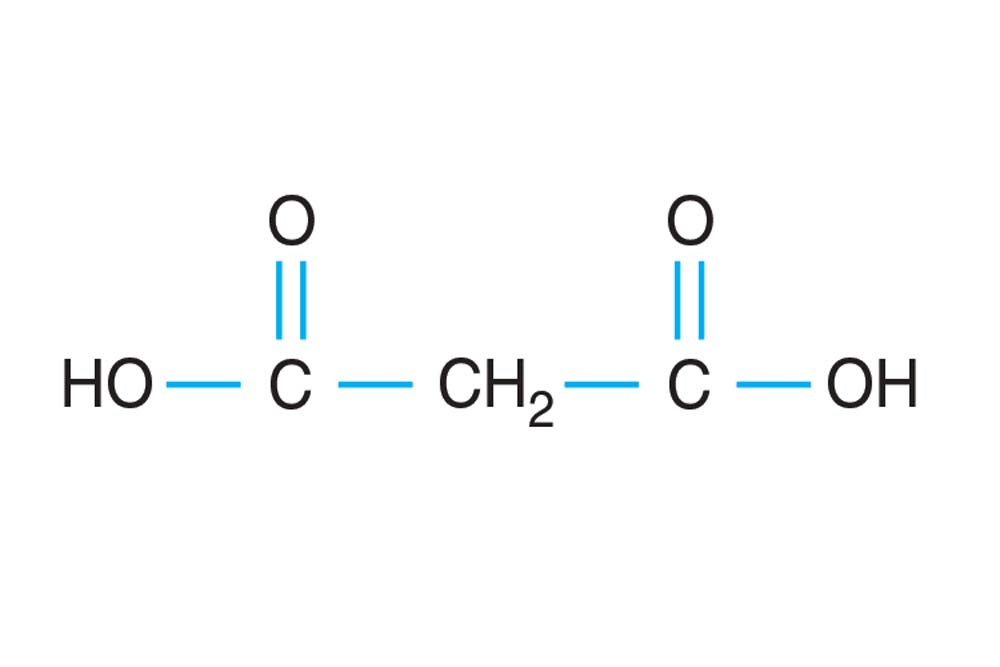
Click to Zoom In
CAT NO
HR2-747
NAME
3.4 M Sodium malonate pH 4.0
DESCRIPTION
200 mL
PRICE
$98.00
cart quote
CAT NO
HR2-749
NAME
3.4 M Sodium malonate pH 5.0
DESCRIPTION
200 mL
PRICE
$98.00
cart quote
CAT NO
HR2-751
NAME
3.4 M Sodium malonate pH 6.0
DESCRIPTION
200 mL
PRICE
$98.00
cart quote
CAT NO
HR2-707
NAME
3.4 M Sodium malonate pH 7.0
DESCRIPTION
200 mL
PRICE
$98.00
cart quote
CAT NO
HR2-807
NAME
3.4 M Sodium malonate pH 8.0
DESCRIPTION
200 mL
PRICE
$98.00
cart quote
Support Material(s)
 HR2-747 Sodium malonate pH 4.0 SDS
HR2-747 Sodium malonate pH 4.0 SDS HR2-749 Sodium malonate pH 5.0 SDS
HR2-749 Sodium malonate pH 5.0 SDS HR2-751 Sodium malonate pH 6.0 SDS
HR2-751 Sodium malonate pH 6.0 SDS HR2-707 Sodium malonate pH 7.0 SDS
HR2-707 Sodium malonate pH 7.0 SDS HR2-807 Sodium malonate pH 8.0 SDS
HR2-807 Sodium malonate pH 8.0 SDS pH/Dilution Table for Sodium Malonate
pH/Dilution Table for Sodium Malonate Certificate Of Analysis
References
1. A comparison of salts for the crystallization of macromolecules. Alexander McPherson. Protein Science (2001), 10:418-422.
2. Crystallization of the PX domain of cytokine-independent survival kinase (CISK): improvement of crystal quality for X-ray diffraction with sodium malonate. Yi Xing and Wenqing Xu. Acta Cryst. (2003). D59, 1816-1818.
3. Malonate: a versatile cryoprotectant and stabilizing solution for salt-grown macromolecular crystals. T. Holyoak, T. D. Fenn, M. A. Wilson, A. G. Moulin, D. Ringe and G. A. Petsko. Acta Cryst. (2003). D59, 2356-2358.
4. Purification, crystallization and preliminary crystallographic analysis of Est25: a ketoprofen-specific hormone-sensitive lipase. Kim et al Acta Cryst. (2007). F63, 579–581.


Hampton Research, first in crystallization since 1991, developing and delivering crystallization and optimization screens, reagents, plates, and other tools for the crystallization of biological macromolecules, including proteins (antibody), peptides (insulin), and nucleic acids (DNA).
- Products
- Gallery
- My Account
|
|
|
- Contact Us
- Quick Order
- Support
|
- Privacy Policy
- Terms and Conditions
|
- Products
- Gallery
- My Account
- Support
- Contact Us
- Quick Order
- Privacy Policy
- Terms and Conditions
|
|
|
|
|
|
|
© 2021 HAMPTON RESEARCH CORP.
| Website by Skyhound Internet
lumiprobe荧光染料JOE azide, 5- isomer
lumiprobe荧光染料官网代理商 水溶性荧光染料代理商 脂溶性荧光染料代理商
- Products
- Reactive dyes
- Dye azides
- JOE azide, 5- isomer
JOE azide, 5- isomer
| Cat. # | Quantity | Price | Lead time | Buy this product | ||
|---|---|---|---|---|---|---|
| 31130 | 500 uL, 10 mM/DMSO | please inquire |
||||
| A1130 | 1 mg | 110.00$
|
||||
| B1130 | 5 mg | 210.00$
|
||||
| C1130 | 10 mg | 310.00$
|
||||
| D1130 | 25 mg | 410.00$
|
||||
| E1130 | 50 mg | 695.00$
|
||||
| F1130 | 100 mg | 1190.00$
|
||||
JOE is a fluorescent dye with the emission in yellow region of the spectrum. The fluorophore matches channel of HEX dye, another chlorinated fluorescein.
JOE dye is often used in qPCR; oligo labeling can be achieved using Click chemistry. This is an azide derivative of JOE for Click chemistry, pure 5-isomer.



Download in
ChemDraw format
Absorption and emission spectra of JOE dye

Recommended protocol
Customers also purchased with this product
Sulfo-Cyanine3 azide
Water-soluble sulfo-Cyanine3 dye azide for Click Chemistry.
SacII(星选酶)–NEB酶试剂
SacII(星选酶) 收藏


















Download:
识别位点
- isoschizomers |
- compatible ends |
- single letter code
在不同反应缓冲液的活性
NEBuffer 1.1: 10%
NEBuffer 2.1: 100%
NEBuffer 3.1: 10%
CutSmart Buffer: 100%
特性
CutSmart、重组酶、省时酶。
反应条件
CutSmart 缓冲液,37℃。
热失活:65℃ 20 分钟。
浓度
20,000 units/ml。
甲基化敏感性
对哺乳动物基因组 DNA CpG 甲基化敏感。
注意事项
某些 Sacll 的识别位点不能被切割,如 λDNA 右臂上的 Sacll 识别位点,有关底物位点优势效应详情请登陆:www.neb-china.com,www.neb.com 。
Silica Gel, Large Granular, Green 硅胶,大颗粒,绿色 品牌:FUJIFILM Wako
Silica Gel, Large Granular, Green
硅胶,大颗粒,绿色
|
品牌:FUJIFILM Wako
CAS No.:63231-67-4 储存条件:室温 纯度:– |
| 产品编号
(生产商编号) |
等级 | 规格 | 运输包装 | 零售价(RMB) | 库存情况 | 参考值 |
|
194-16665 |
– | 500g | – | 370.00 | – | – |
* 干冰运输、大包装及大批量的产品需酌情添加运输费用
* 零售价、促销产品折扣、运输费用、库存情况、产品及包装规格可能因各种原因有所变动,恕不另行通知,确切详情请联系上海金畔生物科技有限公司。
螺口管(样品管、冷冻管),2.0毫升,聚丙烯, 可站立底,500 个/盒,非消毒,8 盒/箱 品牌:Biologix
螺口管(样品管、冷冻管),2.0毫升,聚丙烯, 可站立底,500 个/盒,非消毒,8 盒/箱
|
品牌:Biologix
CAS No.: 储存条件:室温 纯度:– |
| 产品编号
(生产商编号) |
等级 | 规格 | 运输包装 | 零售价(RMB) | 库存情况 | 参考值 |
|
81-0204 |
– | 4000个/箱 | – | 咨询 | – | – |
* 干冰运输、大包装及大批量的产品需酌情添加运输费用
* 零售价、促销产品折扣、运输费用、库存情况、产品及包装规格可能因各种原因有所变动,恕不另行通知,确切详情请联系上海金畔生物科技有限公司。
MKL2/MRTF-B 抗体 MKL2/MRTF-B Antibody
MKL2/MRTF-B 抗体
MKL2/MRTF-B Antibody
MKL2/MRTF-B Antibody recognizes endogenous levels of total MKL2/MRTF-B protein.Polyclonal antibodies are produced by immunizing animals with a synthetic peptide corresponding to residues surrounding Gln1081 of human MKL2/MRTF-B protein. Antibodies are purified by protein A and peptide affinity chromatography.
| 货号 | 产品名称 | 品牌 | 购买 |
|---|
| 货号 | 名称 | 单位 | 购买 |
|---|---|---|---|
| 14613S | MKL2/MRTF-B 抗体 | 100µl | 咨询客服 |
CUG β半乳糖苷酶检测 荧光蓝(停产) 货号14003-AAT Bioquest荧光染料
上海金畔生物科技有限公司代理AAT Bioquest荧光染料全线产品,欢迎访问AAT Bioquest荧光染料官网了解更多信息。
CUG β半乳糖苷酶检测 荧光蓝(停产)
| 货号 | 14003 | 存储条件 | 在零下15度以下保存, 避免光照 | |
| 规格 | 10 mg | 价格 | 0 | |
| Ex (nm) | 352 | Em (nm) | 407 | |
| 分子量 | 368.29 | 溶剂 | DMSO | |
| 产品详细介绍 | ||||
简要概述
产品基本信息
货号:14003
产品名称:CUG β半乳糖苷酶检测 荧光蓝(停产)
规格:10mg
储存条件:-15℃避光防潮
保质期:12个月
产品物理化学光谱特性
分子量:368.29
溶剂:DMSO
激发波长(nm):486
发射波长(nm):448
产品介绍
CUG β半乳糖苷酶检测 荧光蓝是美国AAT Bioquest生产的用于检测β半乳糖苷酶的试剂,CUG是具有羧基反应性手柄的荧光半乳糖苷酶底物,可用于缀合。7-羟基香豆素的有机和无机酯和糖苷是最常用的荧光底物。这些底物在与酶相互作用时产生水溶性蓝色荧光香豆素荧光团。金畔生物是AAT Bioquest的中国代理商,为您提供最优质的CUG β半乳糖苷酶检测 荧光蓝。
点击查看光谱
参考文献
The translation of an antiapoptotic protein HIAP2 is regulated by an upstream open reading frame
Authors: Warnakulasuriyarachchi D, Ungureanu NH, Holcik M.
Journal: Cell Death Differ (2003): 899
Absence of effect of varying Thr-Leu codon pairs on protein synthesis in a T7 system
Authors: Cheng L, Goldman E.
Journal: Biochemistry (2001): 6102
The CUG-binding protein binds specifically to UG dinucleotide repeats in a yeast three-hybrid system
Authors: Takahashi N, Sasagawa N, Suzuki K, Ishiura S.
Journal: Biochem Biophys Res Commun (2000): 518
An AUG initiation codon, not codon-anticodon complementarity, is required for the translation of unleadered mRNA in Escherichia coli
Authors: Van Etten WJ, Janssen GR.
Journal: Mol Microbiol (1998): 987
A carboxyl-terminal domain in fibroblast growth factor (FGF)-2 inhibits FGF-1 release in response to heat shock in vitro
Authors: Shi J, Friedman S, Maciag T.
Journal: J Biol Chem (1997): 1142
Fibroblast growth factor 3, a protein with dual subcellular localization, is targeted to the nucleus and nucleolus by the concerted action of two nuclear localization signals and a nucleolar retention signal
Authors: Antoine M, Reimers K, Dickson C, Kiefer P.
Journal: J Biol Chem (1997): 29475
Molecular characterisation of the pifC gene encoding translation initiation factor 3, which is required for normal photosynthetic complex formation in Rhodobacter sphaeroides NCIB 8253
Authors: Babic S, Hunter CN, Rakhlin NJ, Simons RW, Phillips-Jones MK.
Journal: Eur J Biochem (1997): 564
Increased ribosomal accuracy increases a programmed translational frameshift in Escherichia coli
Authors: Sipley J, Goldman E.
Journal: Proc Natl Acad Sci U S A (1993): 2315
Effect of structure of the initiator codon on translation in E. coli
Authors: Khudyakov Yu E, Neplyueva VS, Kalinina TI, Smirnov VD.
Journal: FEBS Lett (1988): 369
Proti-Ace • Proti-Ace 2蛋白结晶试剂盒Hampton Research
Hampton Research蛋白结晶试剂盒






Products > Optimization Screens > Proti-Ace > Proti-Ace • Proti-Ace 2
Proti-Ace • Proti-Ace 2
Applications
- Limited proteolysis, in situ proteolysis, and proteolytic screening of protein samples for crystallization and structure determination
Features
- Proti-Ace proteases
- alpha-Chymotrypsin
- Trypsin
- Elastase
- Papain
- Subtilisin
- Endoproteinase Glu-C
- Proti-Ace 2 proteases
- Proteinase K
- Clostripain (Endoproteinase-Arg-C)
- Pepsin
- Thermolysin
- Bromelain
- Actinase E
- Optimized, stable, freeze dried protease formulation
Description
A proteolytic fragment or domain of a protein may crystallize more readily or form better diffracting crystals than the intact protein.1-8
Proteases can be used to generate small, active fragments or domains of the target protein for crystallization.9 The fragment or domain can be used directly for crystallization experiments. Or the proteolytic sample analyzed by gel electrophoresis and/or mass spectrometry for mass and sequence for subsequent cloning, expression, purification and crystallization. Using proteolysis to enhance sample crystallization, the current overall success rate for yielding a deposited crystal structure is currently better than 12%.3
Proti-Ace (HR2-429) contains three aliquots of 6 unique proteases (a-Chymotrypsin, Trypsin, Elastase, Papain, Subtilisin and Endoproteinase Glu-C) and six aliquots of Proti-Ace Dilution Buffer. Each protease is supplied in a stable, lyophilized format in an optimized digest buffer. Simply add water when ready to use.
Proti-Ace 2 (HR2-432) contains three aliquots of 6 unique proteases (Proteinase K, Clostripain (Endoproteinase-Arg-C), Pepsin, Thermolysin, Bromelain and Actinase E) and six aliquots of Proti-Ace Dilution Buffer. Each protease is supplied in a stable, lyophilized format in an optimized digest buffer. Simply add water when ready to use.
The unique freeze dried formulation of the Proti-Ace kits offers a much improved protease stability compared to liquid protease formulations.

Click to Zoom In
CAT NO
HR2-429
NAME
Proti-Ace™
DESCRIPTION
tube format
PRICE
$251.00
cart quote
CAT NO
HR2-432
NAME
Proti-Ace™ 2
DESCRIPTION
tube format
PRICE
$251.00
cart quote
Support Material(s)
 HR2-429 Proti-Ace User Guide
HR2-429 Proti-Ace User Guide HR2-429 Proti-Ace SDS
HR2-429 Proti-Ace SDS HR2-432 Proti-Ace 2 User Guide
HR2-432 Proti-Ace 2 User Guide HR2-432 Proti-Ace 2 SDS
HR2-432 Proti-Ace 2 SDS Proti-Ace Enzyme Mr pI Specificty Source
Proti-Ace Enzyme Mr pI Specificty Source Related Item(S)
- Individual Proti-Ace & Proti-Ace 2 Reagents
References
1. Allan D′Arcy, personal communication, 1989-2009.
2. In situ proteolysis for protein crystallization and structure determination. Dong, A et al. Nature Methods – 4, 1019 – 1021 (2007).
3. In Situ Proteolysis to Generate Crystals for Structure Determination: An Update. Amy Wernimont, Aled Edwards. PLoS ONE 4(4): e5094. doi:10.1371/ journal.pone.0005094.
4. The use of in situ proteolysis in the crystallization of murine CstF-77. Tong et al. Acta Cryst. (2007). F63, 135-138.
5. A brief history of protein crystal growth. McPherson, A. Journal of Crystal Growth, vol. 110, issue 1-2, pp. 1-10, 1991.
6. Preparation and analysis of protein crystals. McPherson, A. John Wiley & Sons, Inc. 1982. ISBN 089464355X.
7. A crystallizable form of the Streptococcus gordonii surface antigen SspB C-domain obtained by limited proteolysis. Forsgren et al. Acta Cryst. (2009). F65, 712-714.
8. Preliminary X-ray analysis of a human VH fragment at 1.8 angstrom resolution. Gaur, Kupper, Fischer & Hoffman. Acta Cryst. (2004). D60, 965-967.
9. Replication Protein A Characterization and Crystallization of the DNA Binding Domain. Pfuetzner et al. The Journal of Biological Chemistry, Vol. 272, No. 1, Issue of January 3, pp. 430-434, 1997.
10. Combining in situ proteolysis and mass spectrometry to crystallize Escherichia coli PgaB. Little et al. Acta Cryst. (2012) F68, 842-845.
11. Proteolysis of Native Proteins – Trapping of a Reaction Intermediate. Chenyi Wu, Duncan H. L. Robertson, Simon J. Hubbard, Simon J. Gaskell and Robert J. Beynon. doi: 10.1074/jbc.274.2.1108 January 8, 1999 The Journal of Biological Chemistry, 274, 1108-1115.
12. Crystallization of mouse RIG-I ATPase domain: in situ proteolysis. Civril F, Hopfner KP. Methods Mol Biol. 2014;1169:27-35. doi: 10.1007/978-1-4939-0882-0_3.
13. Crystallization and preliminary X-ray crystallographic analysis of YfcM: an important factor for EF-P hydroxylation. K. Kobayashi, T. Suzuki, N. Dohmae, R. Ishitani and O. Nureki. Acta Cryst. (2014). F70, 1236-1239 [ doi:10.1107/S2053230X14015726 ]. Synopsis: in situ proteolysis crystallization method produces crystals diffracting to 1.45 Å


Hampton Research, first in crystallization since 1991, developing and delivering crystallization and optimization screens, reagents, plates, and other tools for the crystallization of biological macromolecules, including proteins (antibody), peptides (insulin), and nucleic acids (DNA).
- Products
- Gallery
- My Account
|
|
|
- Contact Us
- Quick Order
- Support
|
- Privacy Policy
- Terms and Conditions
|
- Products
- Gallery
- My Account
- Support
- Contact Us
- Quick Order
- Privacy Policy
- Terms and Conditions
|
|
|
|
|
|
|
© 2021 HAMPTON RESEARCH CORP.
| Website by Skyhound Internet
lumiprobe荧光染料PEP azide
lumiprobe荧光染料官网代理商 水溶性荧光染料代理商 脂溶性荧光染料代理商
- Products
- Reactive dyes
- Dye azides
- PEP azide
PEP azide
| Cat. # | Quantity | Price | Lead time | Buy this product |
|---|---|---|---|---|
| A4530 | 1 mg | 110.00$
|
||
| B4530 | 5 mg | 210.00$
|
||
| C4530 | 10 mg | 310.00$
|
||
| D4530 | 25 mg | 410.00$
|
||
| E4530 | 50 mg | 695.00$
|
Phenylethynylpyrene (PEP) fluorophore is a polyaromatic hydrocarbon label with high sensitivity to microenvironment. Similarly to pyrene, PEP dye readily forms excimers. However, PEP fluorescence is more red-shifted
PEP can be used as microenvironment probe, and as a label for assays based on excimer formation.
This reagent contains triethyleneglycol linker to facilitate dissolution of non-polar PEP dye in organo-aqueous labeling reaction mixtures. With this azide, and Click Chemistry, it is easy to turn any molecule bearing alkyne into PEP-labeled probe.
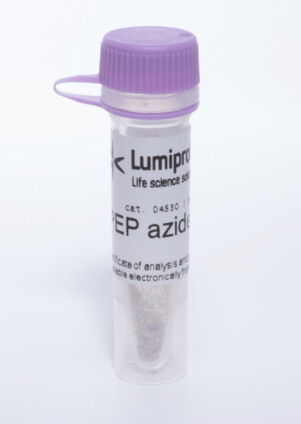

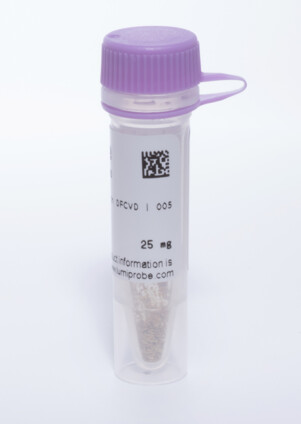
Download in
ChemDraw format
Spectra of PEP (phenylethynylpyrene) in ethanol
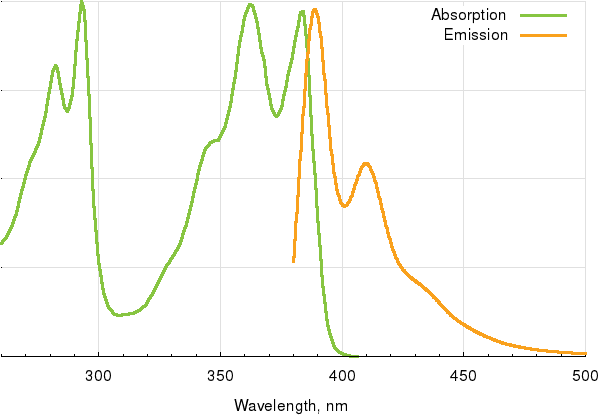
Recommended protocol
Customers also purchased with this product
BDP 581/591 amine
BDP 581/591 fluorophore derivative with free amine group for the conjugation with electrophilic reagents, and enzymatic transamination.






